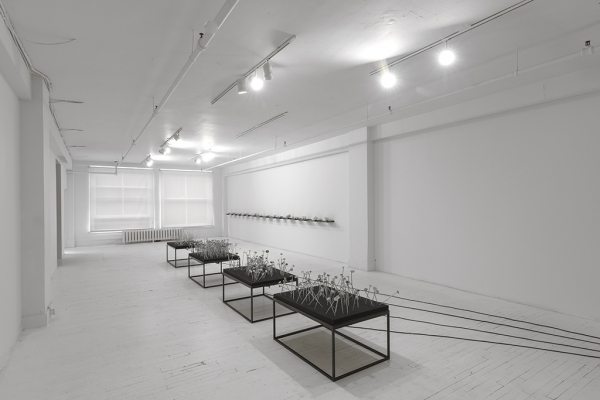Landslides
In her work, Amélie Proulx starts from the premise that clay, before being fired, is endlessly flexible and malleable but then becomes fixed, immutable even. She seeks to restore its original elasticity without ever hiding the durability of its fired state. The artist presents porcelain in various ways to amplify its characteristics, its acoustic qualities, its geological movements; she reveals both its fragility and its flexibility. As a result, Proulx’s work stirs up many metaphors associated with the rich semiotic baggage of her material of predilection: the constant transformation of the world, the mechanics of language, among others.
However, if Amélie Proulx seeks to underline the qualities identified with porcelain, at times she also challenges them. Her handling of ceramic reshapes our understanding of observable physical manifestations. Proulx translates the natural phenomena that interest her into inspiring images
and marvellous mechanized installations. At times, the artist goes as far as making the viewer the instigator of the movements and processes of her work. When this is the case, Amélie Proulx’s interactive pieces offer a multisensory experience. As the conductor of a work’s music and movements, one can investigate its astute functioning or simply enjoy administrating it. Ultimately, the artist counts on the public’s capacity for subjective action to determine the outcome of the work.
While this exhibition might not include interactive pieces, the artist chose, however, to display a kinetic sound installation inspired by the movement of seawater. On low structures, pivoting panels move up and down according to their programmed trajectory. Small porcelain pieces sitting on these steel plates rattle, their fragile bodies clink against each other in a blaring refrain of bells. In Montagne réversible, wall pieces produced during a residency at the European Ceramic Work Centre in the Netherlands, Proulx presents oversized moulds of the inside of her hands. During the technical transfer, the artist’s fingerprints disappeared leaving lines that instead recall topographical maps. Assembled in various ways, Proulx constructs a landscape that is both her own and the result of a technological operation, a cartography that is simultaneously intimate and anonymous.
Through the various tactics she deploys, Amélie Proulx’s work shifts between the desire to conceal and disclose, between organic and mechanized movements, between natural occurrences and human intervention. Her work does not attempt to explain anything; rather, it praises the beauty of unexplained phenomena and enigmatic spaces. Proulx triggers naïve behaviour that we might associate with childhood, but which is essential to the feeling of wonderment her work produces.
A text by Anaïs Castro translated by the author
Amélie Proulx is a multidisciplinary artist living and working in Quebec City. She is interested in possible shifts in meanings in language and in the perception of natural phenomena. She graduated with a MA from the Nova Scotia College of Art and Design University in Halifax. Her artwork has been presented in solo and group exhibitions in Canada, the United States, Australia and France. In 2013, she received the RBC Emerging Artist People’s Choice Award at The Gardiner Museum in Toronto. She has participated in several residencies, notably at the Frans Masereel Centrum in Belgium, 2006, at the Centre for Art Tapes in Halifax in 2010 and at the European Ceramic Work Centre in Holland in 2014. In 2015, she will be in residence at the Guldargergaard International Ceramic Research Centre in Denmark where she will continue her research on the potential movement of porcelain, a material considered unchanging over time.
Anaïs Castro is an independent curator and an art critic based in Montreal. She obtained a Bachelor of Fine Arts in Art History from Concordia University and a Masters in Contemporary Art: History, Curating, and Criticism from the University of Edinburgh in Scotland. She has worked on various curatorial projects in Scotland, Italy and Canada, including Porcelain: Breaking Tradition presented at Art Mûr and Division Gallery in Toronto, Monochrome3 and her most recent project titled Moving Still | Still Moving. Castro has published essays in various art magazines such as Line Magazine, esse arts + opinions and Espace. Since 2013, she has worked as an Assistant Director for Art Mûr.


























